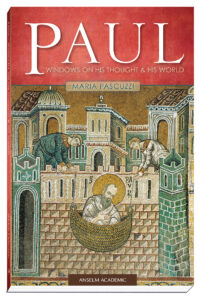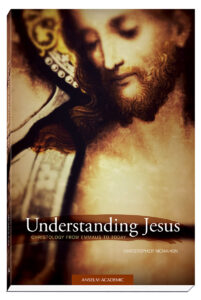The Jesus Movement and the World of the Early Church
About This Book
Overview
The Jesus Movement and the World of the Early Church explores the life and times of Jesus, his disciples, and the New Testament writers. Using multiple historical sources, Sheila McGinn offers a narrative history of Christianity’s first one hundred years—exploring the political, social, and economic world in which the New Testament documents were produced and collected, and tracing challenges and developments as the Jesus movement arose and interacted with the wider world of the Roman Empire.
Details
| Weight | 0.95 lbs |
|---|---|
| Dimensions | 5.375 × 1.5 × 8.25 in |
| Format | Softcover |
| Print ISBN | 978-1-59982-156-6 |
| Pages | 394 |
| Item # | 7049 |
|---|
Customer Reviews
“The Jesus Movement and the World of the Early Church is a solid, simple, straightforward introduction for the undergraduate or general reader to the Jesus movement in its complex cultural and historical world. The people, places, and objects of that world are clearly explained in text and glossaries. This is an excellent resource for the beginning reader.”
United States-Canada Province
“Sheila McGinn’s book, The Jesus Movement and the World of the Early Church, is a masterful example of an important and difficult genre: the scholar’s presentation, for an intelligent and educated but nonspecialist audience, of a large and complicated topic. Her topic is the development of Christianity from Jesus into the period of the apostolic fathers, or ‘How did Christianity get to basically what we have today: a hierarchically organized institutional Church with a strong minor chord of prophetic egalitarianism?’ She does this by treating briefly but adequately all the New Testament writings and some of the early noncanonical writings in their sociopolitical, economic, and religious contexts. In the process she educates her readers in how to handle ancient historical writings so that these readers can not only understand what she is presenting but treat it critically and relate it to other such treatments, which they will now be able to handle. This will be a valuable text for beginning theology students, parish education programs, and independent lay readers.”
Santa Clara University
“The Jesus Movement and the World of the Early Church is a fascinating, decade-by-decade synopsis of earliest Christianity from Caesar Augustus through Emperor Trajan. Using visual and material culture alongside biblical, Greek, and Latin writings, McGinn has written a condensed version of the history from Jesus through Bishop Ignatius that summarizes most New Testament writings, the Didache, and 1 Clement. An especially notable aspect of her book is extensive use of information from the writings of Eusebius, as well as from Josephus and those Roman historians who wrote about this period of time.”
Table of Contents
Introduction
1. The World Jesus Inherited
- Empires and Ideologies: From Cyrus to Caesar
- Roman Imperium and Religion
- The Way of Jesus versus the Ways of Rome
- Varieties of “Judaism” in the First Century CE
- Historical Sources and Their Uses
- Why Bother with History?
- Summary
2. The World of Jesus (21–30 CE)
- Herod the Great
- Pontius Pilate
- Between Herod and Pilate: Supporting Roles on the Roman Stage
- Seeds of Unrest before “Messiah” Jesus
- Unlikely “Historical” Traditions
- Summary
3. Life after Jesus (31–40 CE)
- The Jerusalem Community in the Book of Acts
- Developments among the Early Disciples
- The “Followers of the Way”
- The “Hellenists” and the “Gentile Question”
- Developing Evangelism of Non-Jews
- James “the Just” and the Jerusalem Community
- The Growing Mission to Non-Jews
- Summary
4. Early Missionary Expansion (41–50 CE)
- Rulers in Jerusalem and Rome
- Missionary Expansion among Gentiles
- The House-Church
- The Jesus-Movement in Rome
- Early Missionary Strategies
- Missionary Journeys of Barnabas, Paul, and Companions
- Summary
5. Pressing on Toward the Goal: The Developing Gospel Mission (51–60 CE)
- Paul of Tarsus
- The Jerusalem Council
- Barnabas and the Cypriote Mission
- Paul, Silas, and the Mission to Asia and Macedonia
- Lydia of Thyatira
- On to Greece
- Addressing the “Circumcision Question”—Again
- Christ-Believers in Ephesus
- Paul’s Corinthian Correspondence
- The Letter to Philemon
- Paul’s Final Letter—To the Romans
- Paul’s Journey to Jerusalem
- Origins and Challenges of the Believing Communities in Rome
- Summary
6. Ferment and Fire: Christ-believers in (and against) the Roman Empire (61–70 CE)
- Paul and the Believers in Jerusalem
- Traditions about Peter in Rome
- Emperor Nero’s Persecution of the Christ-Believers
- The First Jewish War of Liberation from Rome
- Developments in the Wider Empire
- Summary
7. Life from the Ashes (71–80 CE)
- Renewal of the Pax Romana
- Second-Generation Christ-Believers
- Meeting the Need for New Holy Books
- The Gospel according to Mark
- Writings in the Pauline Tradition: Colossians and Ephesians
- Alternative Views Engaging the Pauline Traditions: James
- Summary
8. Coming to Terms with Life in the Roman Empire (81–90 CE)
- The Roman Regime: Protests and Punishments
- Important Documents for Understanding This Period
- Developing Ecclesial Structures: The Gospel according to Matthew
- Challenges on the Roman Frontier
- Christ-Believers in the Milieu of the Roman Empire: Luke-Acts
- Summary
9. Christ-Believers’ Responses to Roman Pressures to Conform (91–100 CE)
- Domitian Degenerates
- Did Domitian Persecute Christ-Believers?
- Nerva’s Succession and the Domitianic Damnatio Memoriae
- Christian Writings from the 90s
- The Community of the Beloved Disciple: The Gospel according to John
- The Johannine Community Viewed from the Epistles: 1–3 John
- John the Seer and the Communities of Asia Minor: Revelation
- Clement and the Communities of Rome and Corinth: 1 Clement
- Summary
10. Peace and Prosperity (101–110 CE)
- Second Thessalonians and the Cursus Honorum
- Trajanus Optimus: The Most Excellent Trajan
- The Plight of the Poor
- Other Ecclesial Writings of the Period
- Summary
11. Martyrdom and Monarchy (111–120 CE)
- Trajan, Pliny the Younger, and the Christ-Believers
- Imperial Expansion
- The Diaspora Revolt(s) of 114–117 CE
- Ignatius of Antioch, Bishop and Martyr
- The Pastoral Epistles
- The Acts of Paul and Thecla
- Summary
Conclusion
Appendix 1: Paul and His Theology
- Who Was Paul?
- The Letters of Paul
- Key Themes in Paul’s Theology
- Conclusion
Appendix 2: The Logion-Quelle
Appendix 3: Glossary
Appendix 4: Important People in the Second Testament Era
Bibliography
Index
Professional Reviews
“This is a college text for generally educated readers not prepared to read the specialized literature in biblical studies and ancient history. Questions for review and for discussion appear at the end of each substantive chapter, and appendices include an account of Paul and his theology, the Logion-Quelle, a glossary, a who’s who, and a select bibliography. The scholarship behind the account is current, so that nonstudent readers may find it useful for updating their knowledge of the early Christian movement. We use the term Christian with the proviso that movement participants did not think of themselves as Christians rather than Jews until well into the history of the movement.
“The preface and occasional later reminders point to the difficulties of reading New Testament passages as history, the difficulty of dating them, and the differences between our notions of history and the ancients’ use of history for entertainment and commentary. Fundamentalists will be uncomfortable with this book; scholars will be impressed with its balance.
“Ch. 1 is a brief history of the Hellenistic world. The subsequent chapters proceed decade by decade through the first century of the Christian movement, paralleling it with the history of the Roman emperors and, where relevant, the major officials and Herodian kings in Palestine. This parallel political history helps provide contexts for the Christian movement as reflected in its literature. This is important because the world of the Roman Empire was very much a political and military world (not an honor/shame theater, as some commentators insist).
“Ch. 2 describes the world of Jesus, introducing the reader to Herod the Great and Herod Antipas, Pilate, and various bandit kings. It describes the absentee ownership of lands once owned by locals and in the lifetime of Jesus owned by Romans and their urban elite allies.
“Ch. 3 focuses on the conviction that Jesus had been raised, which made his execution by the Romans secondary. The Gospels of Mark, Matthew, and John have the male disciples experiencing the risen Jesus in Galilee, while the Gospel of Luke and Acts of the Apostles has all the disciples experiencing the risen Jesus in Jerusalem, with a mother church led by James the Righteous emerging there. Some followers left Jerusalem and lived in less Jewish settings as hostility developed in the city. When gentiles join the movement and mixed churches develop outside Jerusalem, issues of membership and organization arose.
“Ch. 4 sifts through the limited evidence for the early missionary expansion (41-50 CE). Herod Agrippa I had John Son of Zebedee executed in Jerusalem. Egalitarianism marked the movement for a time, and the issue of circumcision for gentile followers had to be addressed. Paul, Barnabas, and John Mark, member of a relatively elite family, set out on a missionary journey to Cyprus. McGinn refers to the hypothetical role of Sergius Paulus, governor of Cyprus, owning properties in Asia Minor, assisting the mission, with Saul taking the name Paul in his honor. Here I think McGinn should have put more stress on the hypothetical nature of this.
“Ch. 5 introduces the Logion-Quelle (sayings source common to Matthew and Luke) and the authentic letters of Paul. In a reference of the Christian leader, Lydia of Thyatira, McGinn suggests she had two homes—one in Philippi and one in Tyatira. We do not know this was the case; it is hypothetical. McGinn does provide an interesting and well-warranted interpretation of the First Corinthians’ injunction that women wear hair coverings when prophesying—it was an indicator of being a respected woman, not a prostitute or slave, to do so, and that when prophesying women had authority over their heads. The instruction would have an egalitarian effect when lower-status women covered their hair to prophesy. Also interesting: McGinn does not consider Romans 16 to be a separate letter from the rest of Romans.
“Ch. 6 describes the tumultuous era of persecution in Rome by Nero, the Jewish War in Palestine, and the deaths of Peter, Paul, and James the Righteous. McGinn seems to think that the Letter of James was written by James the Righteous (p. 171), probably a minority view among scholars. With the destruction of Jerusalem, the movement lost its center. The flight of Torah-observant Christians out of Palestine led to disputes over Torah-observance in the movement.
“Ch. 7 takes up the organizing of the church within a new period of relative peace. The decade 71-80 features the writing of the Gospel of Mark, Colossians, Ephesians, and, ironically, the Letter of James. There is good reason to put these in the following decade, but little difference in the historical account arises from McGinn’s placing them here.
“Ch. 8 uses the Gospels of Matthew and Luke as data, especially their friendlier stance toward the Roman Empire.
“Ch. 9 records sporadic efforts to force the Christians to conform to Roman ways in the late-first century. Christian literary evidence includes First Clement (noncanonical Roman Church letter to the Corinthian churches) and the Johannine books. Of these, the Gospel of John and the letters of John represent an isolated Christian community more or less reconciled to the Empire, but the book of Revelation adamantly opposed to it.
“Chs. 10 and 11 feature internal organizational developments in the movement (2 Thessalonians and the Pastoral Epistles, and such noncanonical works as the Didache, quotations from Papias of Hierapolis, the letters of Ignatius of Antioch, and the Acts of Paul and Thecla). Not all scholars would date the Pastorals (1 and 2 Timothy, and Titus) in the 111-120 decade.
“In general, I recommend this as an excellent history and background reading for the Christian scriptures. While there are junctures where many scholars would disagree with the author, it must be said that her positions are defensible ones. The volume is not at all out of the mainstream of historical and biblical scholarship.”






